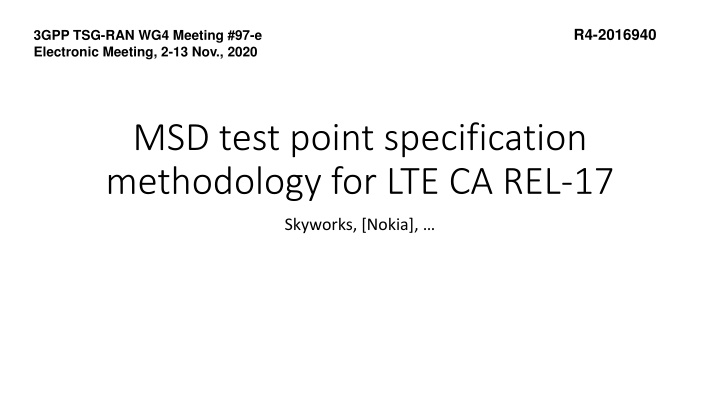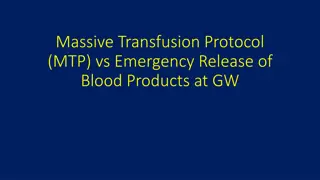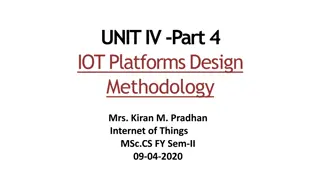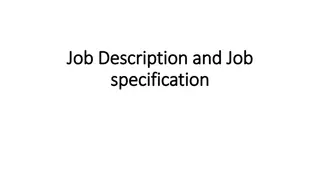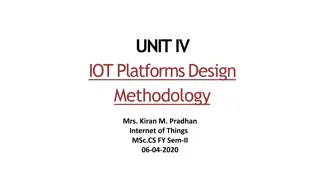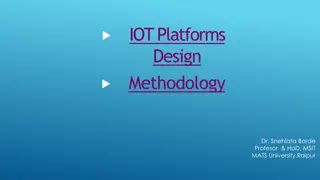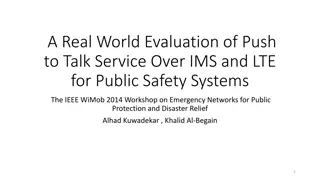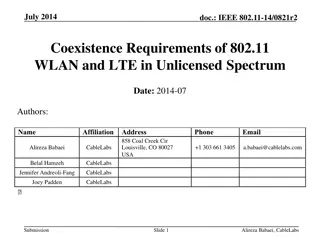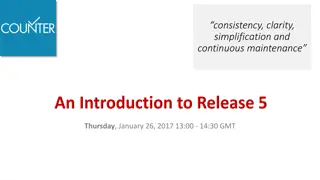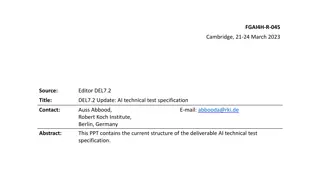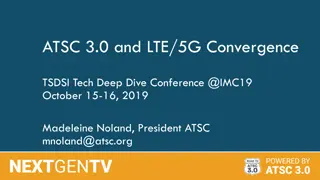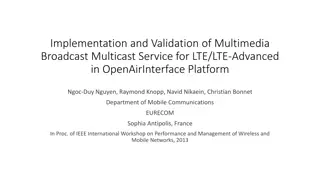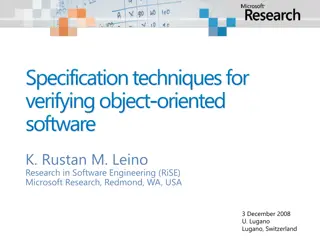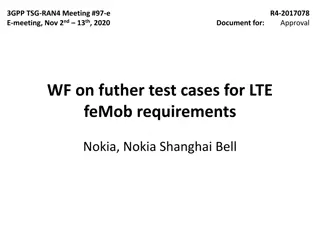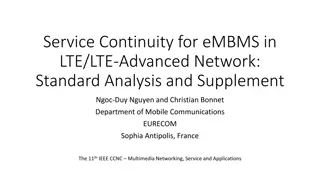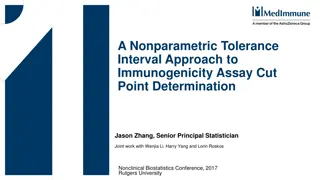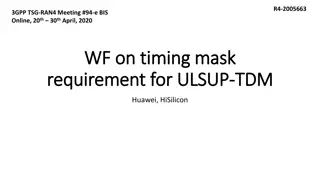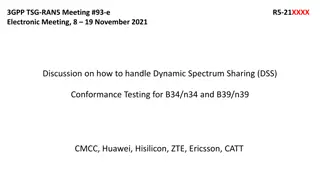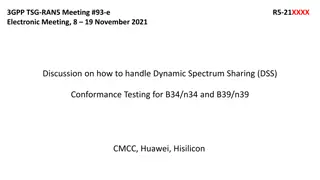Evolution of LTE-CA Test Point Specification Methodology for Release-17
The current LTE-CA MSD test point methodology in LTE releases results in specifying redundant test points. Adopting the NR Way of Working for LTE-CA in Release-17 could simplify the MSD tables, reduce complexity, and cut conformance test time/cost. The proposal aims to prevent further expansion of LTE MSD-CA tables in future releases by adopting NR/EN-DC methodology for new LTE-CA combinations, while considering the handling of legacy LTE-CA MSD test points. Consensus is being sought among companies regarding the adoption and implementation of these changes.
Download Presentation

Please find below an Image/Link to download the presentation.
The content on the website is provided AS IS for your information and personal use only. It may not be sold, licensed, or shared on other websites without obtaining consent from the author.If you encounter any issues during the download, it is possible that the publisher has removed the file from their server.
You are allowed to download the files provided on this website for personal or commercial use, subject to the condition that they are used lawfully. All files are the property of their respective owners.
The content on the website is provided AS IS for your information and personal use only. It may not be sold, licensed, or shared on other websites without obtaining consent from the author.
E N D
Presentation Transcript
3GPP TSG-RAN WG4 Meeting #97-e Electronic Meeting, 2-13 Nov., 2020 R4-2016940 MSD test point specification methodology for LTE CA REL-17 Skyworks, [Nokia],
Background: Current LTE Background: Current LTE- -CA Way of Working (1/3) CA Way of Working (1/3) The current Way of Working (WoW) for LTE-CA REFSENS MSD Test Points (TP) is that, contrary to NR/EN-DC, LTE-CA higher order combinations cannot be exempted from specifying MSD TP even if constituent lower order (eg. 2DL or 3DL CAs) MSD test points have been previously agreed. This results in specifying multiple redundant MSD TP. For example REL-16.7.0 Table 7.3.1A-0bC Reference sensitivity for carrier aggregation QPSK PREFSENS, CA (exceptions for three bands due to close proximity of UL to DL channel) contains 88 MSD TP, out of which 82 are TP for Band 3 MSD due to close proximity of Band 1. Adopting NR WoW could not only reduce significantly the complexity of MSD tables, it may also result in significant conformance test time/cost reduction.
Background: Adopting NR WoW for new REL Background: Adopting NR WoW for new REL- -17 LTE 17 LTE- -CA Combos (2/3) CA Combos (2/3) To prevent further expansion of the LTE MSD CA tables in future Releases, it has been proposed to adopt the NR / EN-DC MSD TP specification methodology for new Release 17 LTE-CA combinations [1]: 2DL/1UL MSD test points cover cases of REFSENS: Exceptions due to harmonic issue, Exceptions due to for two bands due to close proximity of UL to DL channel, Exceptions due to cross band isolation issues of TDD and FDD bands, CA with SDL band, 2DL/2UL MSD test points cover cases of REFSENS: Exceptions for intermodulation interference due to dual uplink operation, Exceptions for intra-band CA, 3DL/2UL MSD test points cover cases of REFSENS: Exceptions for intermodulation interference into third band due to dual uplink operation, No additional MSD test point is needed for higher-order combinations. 1St round comments indicate consensus could be reached as all companies which commented are in favour of this approach.
Background: Handling of Legacy LTE Background: Handling of Legacy LTE- -CA MSD TP (3/3) CA MSD TP (3/3) In principle, the concept could be ported to legacy MSD tables [1] . 1st round comments indicate two different views on this aspect: 5 companies are not in favour of applying the NR methodology to legacy MSD test points due to 1) huge work involved, 2) huge impact on RAN5, and 3) possible confusion across the industry for early LTE release devices. 1 company is in favour of applying the concept to legacy combos, arguing that two separate sets of tables may result in more complicated technical specifications. One company suggested that it would be preferable to prepare an LS to inform RAN5 about RAN4 change of methodology and that RAN5 may choose the suitable test method to simplify the test procedure.
Proposed Way Forward for REL Proposed Way Forward for REL- -17 Technical Specifications (1/2) 17 Technical Specifications (1/2) Proposal 1: For new REL-17 combinations, Adopt NR/EN-DC MSD test point specification methodology for new LTE CA combinations: 2DL/1UL MSD test points cover cases of REFSENS: Exceptions due to harmonic issue, Exceptions due to for two bands due to close proximity of UL to DL channel, Exceptions due to cross band isolation issues of TDD and FDD bands, CA with SDL band, 2DL/2UL MSD test points cover cases of REFSENS: Exceptions for intermodulation interference due to dual uplink operation, Exceptions for intra-band CA, 3DL/2UL MSD test points cover cases of REFSENS: Exceptions for intermodulation interference into third band due to dual uplink operation, No additional MSD test point is needed for higher-order combinations. Proposal 2: Skyworks to work in collaboration with Basket WI Rapporteurs and to bring bigCR at December 2020 plenary to ensure this methodology is implemented in first Release-17 TS 36.101. Proposal 3: As a first step, priority is to streamline REL-17 specifications to prevent further un- necessary MSD table expansion. Therefore, for legacy combinations, do not change MSD TP tables. Proposal 4: Inform RAN5 via an LS about RAN4 change of methodology for new LTE-CA REL-17 combinations and suggest conformance test case reduction opportunity for legacy MSD TP.
Proposed Way Forward for REL Proposed Way Forward for REL- -17 LTE Basket Work Item (2/2) 17 LTE Basket Work Item (2/2) Proposal 5: Rapporteurs to ensure simplifications resulting from new methodology are effective in the Basket WI process: Higher-order LTE CA Text Proposals can not be agreed if lower order fall back specifications are missing, Higher-order MSD test points are no longer needed if constituent lower-order fall-back MSD are agreed and specified. For example, it is expected that for most combinations with >3 bands, MSD test points are not needed, and considerable simplification is expected for >2 band combinations. Corresponding TRs must follow Proposal 1, i.e.: 2DL/1UL MSD test points cover cases of REFSENS: Exceptions due to harmonic issue, Exceptions due to for two bands due to close proximity of UL to DL channel, Exceptions due to cross band isolation issues of TDD and FDD bands, CA with SDL band, 2DL/2UL MSD test points cover cases of REFSENS: Exceptions for intermodulation interference due to dual uplink operation, Exceptions for intra-band CA, 3DL/2UL MSD test points cover cases of REFSENS: Exceptions for intermodulation interference into third band due to dual uplink operation, No additional MSD test point is needed for higher-order combinations
References References [1] R4-2016007 LTE Rel'17 MSD table simplification, Skyworks, Nokia.
